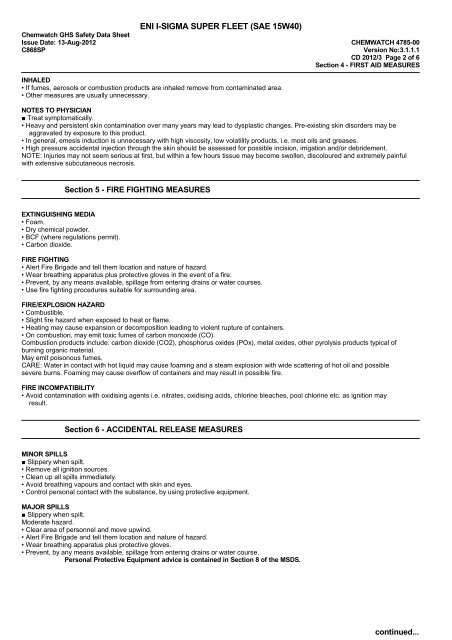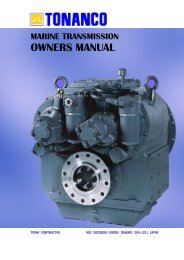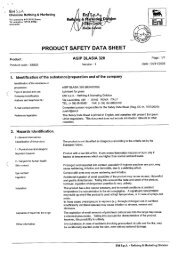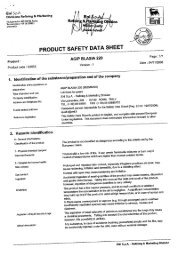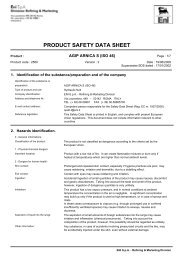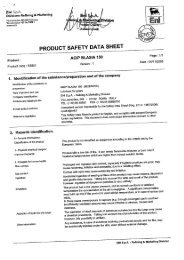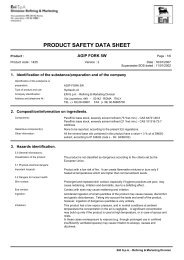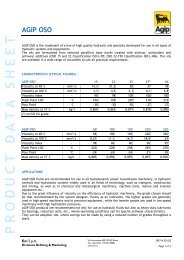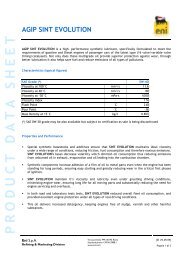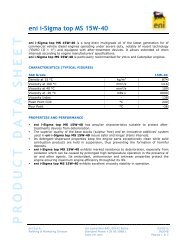eni i-sigma super fleet (sae 15w40) ghs sds 4785-00 - TransDiesel
eni i-sigma super fleet (sae 15w40) ghs sds 4785-00 - TransDiesel
eni i-sigma super fleet (sae 15w40) ghs sds 4785-00 - TransDiesel
You also want an ePaper? Increase the reach of your titles
YUMPU automatically turns print PDFs into web optimized ePapers that Google loves.
ENI I-SIGMA SUPER FLEET (SAE 15W40)<br />
Chemwatch GHS Safety Data Sheet<br />
Issue Date: 13-Aug-2012 CHEMWATCH <strong>4785</strong>-<strong>00</strong><br />
C868SP<br />
Version No:3.1.1.1<br />
CD 2012/3 Page 2 of 6<br />
Section 4 - FIRST AID MEASURES<br />
INHALED<br />
• If fumes, aerosols or combustion products are inhaled remove from contaminated area.<br />
• Other measures are usually unnecessary.<br />
NOTES TO PHYSICIAN<br />
■ Treat symptomatically.<br />
• Heavy and persistent skin contamination over many years may lead to dysplastic changes. Pre-existing skin disorders may be<br />
aggravated by exposure to this product.<br />
• In general, emesis induction is unnecessary with high viscosity, low volatility products, i.e. most oils and greases.<br />
• High pressure accidental injection through the skin should be assessed for possible incision, irrigation and/or debridement.<br />
NOTE: Injuries may not seem serious at first, but within a few hours tissue may become swollen, discoloured and extremely painful<br />
with extensive subcutaneous necrosis.<br />
Section 5 - FIRE FIGHTING MEASURES<br />
EXTINGUISHING MEDIA<br />
• Foam.<br />
• Dry chemical powder.<br />
• BCF (where regulations permit).<br />
• Carbon dioxide.<br />
FIRE FIGHTING<br />
• Alert Fire Brigade and tell them location and nature of hazard.<br />
• Wear breathing apparatus plus protective gloves in the event of a fire.<br />
• Prevent, by any means available, spillage from entering drains or water courses.<br />
• Use fire fighting procedures suitable for surrounding area.<br />
FIRE/EXPLOSION HAZARD<br />
• Combustible.<br />
• Slight fire hazard when exposed to heat or flame.<br />
• Heating may cause expansion or decomposition leading to violent rupture of containers.<br />
• On combustion, may emit toxic fumes of carbon monoxide (CO).<br />
Combustion products include: carbon dioxide (CO2), phosphorus oxides (POx), metal oxides, other pyrolysis products typical of<br />
burning organic material.<br />
May emit poisonous fumes.<br />
CARE: Water in contact with hot liquid may cause foaming and a steam explosion with wide scattering of hot oil and possible<br />
severe burns. Foaming may cause overflow of containers and may result in possible fire.<br />
FIRE INCOMPATIBILITY<br />
• Avoid contamination with oxidising agents i.e. nitrates, oxidising acids, chlorine bleaches, pool chlorine etc. as ignition may<br />
result.<br />
Section 6 - ACCIDENTAL RELEASE MEASURES<br />
MINOR SPILLS<br />
■ Slippery when spilt.<br />
• Remove all ignition sources.<br />
• Clean up all spills immediately.<br />
• Avoid breathing vapours and contact with skin and eyes.<br />
• Control personal contact with the substance, by using protective equipment.<br />
MAJOR SPILLS<br />
■ Slippery when spilt.<br />
Moderate hazard.<br />
• Clear area of personnel and move upwind.<br />
• Alert Fire Brigade and tell them location and nature of hazard.<br />
• Wear breathing apparatus plus protective gloves.<br />
• Prevent, by any means available, spillage from entering drains or water course.<br />
Personal Protective Equipment advice is contained in Section 8 of the MSDS.<br />
continued...


